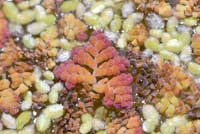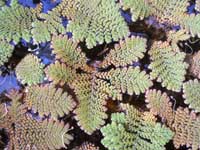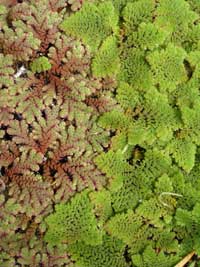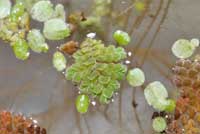Supporting materials
Download
Download this article as a PDF

Vered Yephlach-Wiskerman introduces a classroom project to investigate the bioremediation powers of the aquatic fern Azolla.

When soils or aquatic bodies are contaminated, for example with heavy metals, solvents or oil, one important cleaning option is bioremediation: the use of micro-organisms or plants that will take up the contaminants and either metabolise them into less harmful compounds or accumulate them, allowing them to be removed.
Common applications include cleaning up abandoned mining sites or oil spills. Phytoremediation (from the Greek phyto – plant) uses a plant’s natural ability to contain, degrade or remove toxic chemicals and pollutants from soil or sludge, sediment or ground water.
Azolla is one such plant: this genus of floating freshwater ferns accumulates heavy metals such as nickel, cadmium and mercury (Arora et al., 2006); its biomass is easy to harvest and desiccates very fast (Wagner, 1997). These characteristics make it a perfect candidate for bioremediation systems (Cohen, 2004), although it is always important to assess the potential impact of introducing a new species into an ecosystemw1, w2. Azolla lives in symbiosis with the cyanobacteria Anabaena azollae, which can fix atmospheric nitrogen. This independence of a further external source of nitrogen allows the fern to double its biomass every two to three days at room temperature and is the reason that it has been used in China as a biofertiliser in rice paddies for centuries.

The plant is a great tool for interdisciplinary school projects involving ecology, environmental studies, biology, chemistry and biotechnology. During such a project, students can develop essential skills for scientific work: formulating a problem and a hypothesis, planning an experiment, writing up the results and drawing conclusions.

In the lesson, introduce the topic of bioremediation and have the students collect information about Azollaw1, w3, w4, w5, w6, w7, w8 (Arora & Saxena, 2005), such as the morphology of water plants as opposed to land plants, the importance of symbiosis, the nitrogen cycle, the use of Azolla in agriculture (Pabby et al., 2004), and Azolla’s ability to absorb heavy metals.
Help the students to formulate the research questions and hypotheses that they would like to investigate. Possible topics include measuring the gain in biomass depending on growth conditions (e.g. CO2 level, iron level in the water, amount of light), or the effect of Azolla on water quality.
Teams of two to three students work well, and each experiment should be repeated three times for confirmation. Different teams can work on different aspects of the plant or on the same topic to replicate a single experiment. In the final session, the results can be presented and discussed in class.
Table 1 can help students plan their experiment. The table can also be downloaded from the Science in School websitew8.
| Details of the experiment | Your answer | |
|---|---|---|
| 1 | Formulate your hypothesis. | |
| 2 | What is the biological basis of your hypothesis? | |
| 3 | What is the dependent variable you want to measure in your experiment? How is it measured? In what units? | |
| 4 | What is / are the independent variable(s) you want to change to study its / their effects on the variable in Step 3? How will you change it / them? | |
| 5 | What are the fixed variables in the experiment – those that will not change? | |
| 6 | Detail the controls you intend to include and explain their importance. |
Next, the students should tabulate their experimental results and represent them graphically. They should consider the most appropriate type of graph to use (e.g. line graph or bar chart).
Below is an example of a project suitable for students in Grades 10-12 (aged 16-18). We used Azolla filiculoides, but any of the seven Azolla species will do. They can easily be obtained in plant nurseries or garden centres, aquarium shops or online.

Hypothesis / research question: Azolla will lower water’s conductivity because the plant will absorb available metal ions. Does Azolla influence the water quality in other ways?
To test this hypothesis and answer the question, several parameters that indicate water quality will be monitored over the course of 2 weeks. Apart from measuring the conductivity, we also decided to investigate some aspects of water quality that were easy to test and for which the equipment was readily available.
Students should be familiar with basic plant physiology and the use of the instruments / methods.

To one of the containers, add about 50 g Azolla (add more if the plant is very wet). The second container should be left untreated. To extend the investigation, a third aquatic plant – one that does not absorb heavy metals, such as duckweed (Lemna spp.) – could be used in a third container.
Do not add or change the water during the experiment.

Measure the pH using either a pH meter or a strip test, to get an indication of the carbon dioxide (CO2) concentration. The plant’s cellular respiration should increase the concentration of CO2, lowering the pH.
As a control, you could determine bacterial content by measuring turbidity with a spectrometer or turbidity meter, or by measuring the concentration of colony-forming units using the dilution method, seeding isolation, and counting colonies of bacteria on a rich agar medium. Differing levels of bacteria in the initial water samples may influence the water quality and could falsify results, as bacteria may also take up nutrients and metals.
The cyanobacteria in Azolla produce a neurotoxin, so the plants should not be eaten. In addition, some Azolla species are considered a weed and are an invasive species in many countries, so the plants should be disposed of safely after use. See also the general safety note.
Keeping the environment clean and pollution free as well as monitoring the environment are now major concerns, and these subjects are studied in school science. Natural ways of cleaning up the environment, such as bioremediation by plants and microbes, are ideal and have been studied for many years. This article shows how a common aquatic plant, Azolla, can be used to demonstrate bioremediation in the classroom. The activities foster scientific thinking skills, an essential part of the ‘how science works’ element of the curriculum. A simplified version of this activity could be used with younger students.
The experiments could be linked to chemistry – in tests for cations and anions and titrations. The activity also has links to microbiology and biotechnology, as the students could learn the basics of how microbiological water quality can be monitored. As an extension activity, students could use the Internet find out how microbes can be used to clean up oil spills and how micro-organisms can be selected or genetically engineered to deal with particular contamination problems.
Shelley Goodman, UK
Download this article as a PDF